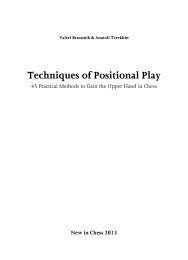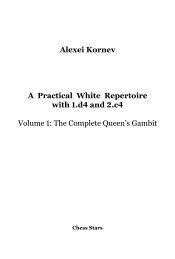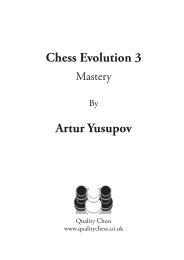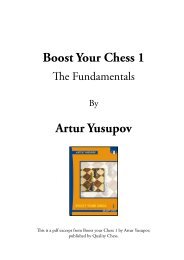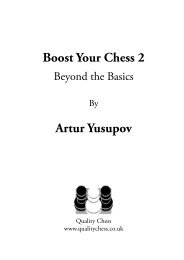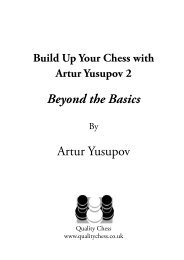Build Up Your Chess 3 – Mastery Artur Yusupov
Build Up Your Chess 3 – Mastery Artur Yusupov
Build Up Your Chess 3 – Mastery Artur Yusupov
Create successful ePaper yourself
Turn your PDF publications into a flip-book with our unique Google optimized e-Paper software.
<strong>Build</strong> <strong>Up</strong> <strong>Your</strong> <strong>Chess</strong> 3 <strong>–</strong><strong>Mastery</strong><strong>Artur</strong> <strong>Yusupov</strong>Quality <strong>Chess</strong>www.qualitychess.co.uk
First English edition 2009 by Quality <strong>Chess</strong> UK LLPCopyright © 2009 <strong>Artur</strong> <strong>Yusupov</strong><strong>Build</strong> up your <strong>Chess</strong> 3 - <strong>Mastery</strong>All rights reserved. No part of this publication may be reproduced, stored in a retrievalsystem or transmitted in any form or by any means, electronic, electrostatic, magnetic tape,photocopying, recording or otherwise, without prior permission of the publisher.ISBN 978-1-906552-26-8All sales or enquiries should be directed to Quality <strong>Chess</strong> UK LLP,20 Balvie Road, Milngavie, Glasgow G62 7TA, United Kingdome-mail: info@qualitychessbooks.co.ukwebsite: www.qualitychessbooks.co.ukDistributed in US and Canada by SCB Distributors, Gardena, Californiawww.scbdistributors.comDistributed in Rest of the World by Quality <strong>Chess</strong> UK LLP throughSunrise Handicrafts, Smyczkowa 4/98, 20-844 Lublin, PolandPhoto by Harald Fietz on pages 19, 33, 55, 147, 191, 225 and 271Photo on page 235 courtesy of Caissia ItaliaTranslated from German by Ian AdamsEdited and typeset by Colin McNabProofreading by John ShawCover Design: Barry AdamsonPrinted in Estonia by Tallinna Raamatutrükikoja LLC
CONTENTSKey to symbols used 4Preface 5Introduction 61 Combinations involving promotion 82 Evaluation of the position 203 Pawn endings 344 Rook against bishop 445 Opening repertoire for White with 1.d4 566 The isolated pawn 687 Playing against the isolated pawn 828 Simple tactics 949 The backward pawn 10410 Bishop endings 11411 French Defence 12412 Training with studies 13813 Blockade 14814 Drawing combinations 16015 Opposite-coloured bishops 16816 Opening repertoire for White with 1.d4 (Part 2) 17817 The elimination method 19218 Hanging pawns 20019 Playing against hanging pawns 21220 Simple tactics 2 22621 Doubled pawns 23622 Opening repertoire for Black against 1.d4 24823 The comparison method 26024 Rook against knight 272Final test 282AppendicesIndex of composers 292Index of games 293Recommended books 300
Key to symbols usedrqWhite to moveBlack to move² White is slightly better³ Black is slightly better± White is betterµ Black is better+<strong>–</strong> White has a decisive advantage<strong>–</strong>+ Black has a decisive advantage= equalityƒ with the initiative‚ with an attack© with compensation„ with counterplay÷ unclear¹ better is… intending only move‡ zugzwang× weak point? a weak move?? a blunder! a good move!! an excellent move!? a move worth considering?! a move of doubtful value# mate4
chapter 18Contentsü The advanced passed pawnin the middlegameü Breakthroughü Use of an open kingpositionü Exchanging defensive piecesü Getting rid of a defenderü Promoting with checkDiagram 1-1r1222222223Çt+ +wT L5Æ+ Ov+ O 5Å + + M O5ÄR + +o+ 5à OpPoP P5Â+ QmP P 5Á + N +r+5À+ +n+ Kb57ÈÉÊËÌÍÎÏ9Combinationsinvolving promotionWe shall now take a look at combinations which involvepromotion. They are often a feature of the endgame,but sometimes you can make use of advanced pawnsin the middlegame.The value of pawns increases dramatically asthey approach the queening square.Frequently a passed pawn can only be stopped at agreat cost in material. To clear the path for a passedpawn, even pieces may sometimes be sacrificed. Hereare a few spectacular examples.8Diagram 1-1E.Bogoljubow <strong>–</strong> A.AlekhineHastings 192230.¦xa8White’s position is already very difficult. But afterthe text move there is a surprise in store for him.30...bxc3!30...£xa8 would not be so strong: 31.£b3 ¥a432.£b1µ31.¦xe8 c2!A typical double attack, on the knight along with asimple promotion on c1.32.¦xf8† ¢h7 33.¤f2 c1=£† 34.¤f1 ¤e1 35.¦h2£xc4Despite the material balance, Black’s position isclearly better. The white pieces are too passive anduncoordinated.36.¦b8 ¥b5 37.¦xb5 £xb5 38.g4 ¤f3† 39.¥xf3exf3 40.gxf5Or 40.g5 ¤g4<strong>–</strong>+.40...£e2!!For the second time, Black exploits the strength ofan advanced pawn.41.d5White is in zugzwang; if 41.¤h3 or 41.¦h3, then41...¤g4!.41...¢g8! 42.h5 ¢h7 43.e4 ¤xe4 44.¤xe4 £xe445.d6 cxd6 46.f6 gxf6 47.¦d2 £e2!
Combinations involving promotionDiagram 1-2A pretty finish. Black forces the transition to a wonpawn ending.48.¦xe2 fxe2 49.¢f2 exf1=£† 50.¢xf1 ¢g751.¢e2 ¢f7 52.¢e3 ¢e6 53.¢e4 d5†0<strong>–</strong>1Diagram 1-3Y.Balashov <strong>–</strong> A.<strong>Yusupov</strong>Minsk 1982To crack open the white fortress, Black needs a passedpawn.74...b4!! 75.axb4 ¥xb2! 76.¦xb2 a3 77.¦d2 a2White now has to give up his rook for the dangerouspassed pawn.78.¦xa2Or 78.¦d1 £c2† 79.¢e1 £xd1†<strong>–</strong>+.78...£xa2† 79.¢e3After 79.¢f1 comes 79...£c4 80.¥e2 £e4<strong>–</strong>+.79...£b1Threatening ...£f1.80.¢e2 ¢c7If 80...£g1, then 81.¤e1.81.¤e1Intending to continue with ¤g2-e3.81...£xb4 82.¤g2 £c4† 83.¢e1 £c1† 84.¢e2£c2† 85.¢e1After 85.¢f1 there follows 85...£d3†.85...f5!<strong>–</strong>+If 85...£d3, then 86.¤e3.86.gxf586.¤xh4 loses to 86...£d3 (threatening ...g5)87.¥g2 (or 87.¥e2 £xh3 88.¤xg6 £h1† 89.¢d2£h6†) 87...£c3† 88.¢e2 fxg4 89.hxg4 £c4†.86...£xf5Black also breaks through on the kingside! Whiteresigned, in view of 87.¥g4Diagram 1-487...£xg4!! 88.hxg4 h3 with the well-known motif:the knight often performs poorly against a rook’spawn.9Diagram 1-2r1222222223Ç + + + +5Æ+ + + +l5Å + O O O5Ä+ + + +p5à + + P +5Â+ + +o+ 5Á + Rw+ +5À+ + +nK 57ÈÉÊËÌÍÎÏ9Diagram 1-3q1222222223Ç + L + +5Æ+ + + + 5Å + + Oo+5Ä+o+pV + 5Ão+w+ +pO5ÂP +n+b+p5Á P RkP +5À+ + + + 57ÈÉÊËÌÍÎÏ9Diagram 1-4 (analysis)q1222222223Ç + + + +5Æ+ L + + 5Å + + +o+5Ä+ +p+w+ 5à + + +bO5Â+ + + +p5Á + + Pn+5À+ + K + 57ÈÉÊËÌÍÎÏ9chapter 1
chapter 1Diagram 1-5q1222222223Ç +lT + T5ÆOoO WoOo5Å +o+ M +5Ä+ V +v+ 5à +p+oP +5Â+p+ P + 5ÁpBqPb+pP5ÀRn+ K +r57ÈÉÊËÌÍÎÏ9Diagram 1-6 (analysis) q1222222223Ç +lT + T5ÆOoO WoOo5Å +o+ + +5Ä+ V +v+ 5à +p+oPm+5Â+pN P + 5ÁpBqPb+pP5ÀR + K +r57ÈÉÊËÌÍÎÏ9Diagram 1-7q1222222223Ç +lT + T5ÆOoO WoO 5Å +o+ + +5Ä+ V +v+o5à +p+oPm+5Â+p+ P Pp5ÁpBqPb+ +5ÀRn+ K +r57ÈÉÊËÌÍÎÏ9Tactics 1A far-advanced pawn may control important squaresin the opposing camp and can completely disrupt thedefence.B.Larsen <strong>–</strong> B.SpasskyUSSR <strong>–</strong> World, Belgrade 19701.b3 e5 2.¥b2 ¤c6 3.c4 ¤f6 4.¤f3 e4 5.¤d4 ¥c56.¤xc6 dxc6 7.e3 ¥f5 8.£c2 £e7 9.¥e2 0<strong>–</strong>0<strong>–</strong>010.f4Diagram 1-510...¤g4! 11.g3After 11.0<strong>–</strong>0 there follows 11...£h4 12.h3 h5 withan attack (Euwe).If 11.¥xg4, then simply 11...£h4†µ (Larsen).And 11.¤c3Diagram 1-6would be bad due to 11...¦xd2! and then 12...¥xe3(Florian).11...h5!Now 11...¦xd2 is not so clear, because of 12.¤xd2¤xe3 13.£c3 (Spassky).12.h3Once more 12.¤c3 is met by 12…¦xd2!<strong>–</strong>+. If13.£xd2 (or 13.¢xd2 ¥xe3†), then 13...¥xe314.£d1 (14.£c2 ¥f2† nets the white queen aftereither 15.¢f1 15...¤e3† or 15.¢d2 e3†) 14...¤f2<strong>–</strong>+(Alexander).Spassky now starts a brilliant attack. His queen andthe strong pawns play the decisive role.Diagram 1-712...h4! 13.hxg413.¥xg4 would be no better: 13…¥xg4 14.hxg4hxg3 15.¦g1 ¦h1! (or 15...¦h2<strong>–</strong>+ Larsen) 16.¦xh1g2 17.¦g1 £h4† 18.¢e2 £xg4† 19.¢e1 £g3†20.¢e2 (20.¢d1 £f2 21.£xe4 £xg1† 22.¢c2£f2<strong>–</strong>+) 20...£f3† 21.¢e1 ¥e7<strong>–</strong>+ (Spassky).13...hxg3 14.¦g114.¦xh8 ¦xh8 15.gxf5 loses to 15...¦h1† 16.¥f1g2.10
Combinations involving promotionDiagram 1-814...¦h1!! 15.¦xh1After 15.¢f1 there follows 15...¦xg1† 16.¢xg1£h4<strong>–</strong>+ (Kotov).15...g2 16.¦f1Or 16.¦g1 £h4† 17.¢d1 £h1 18.£c3 £xg1†19.¢c2 £f2 20.gxf5 £xe2 21.¤a3 and now21...¥b4!<strong>–</strong>+ is the neatest finish, although 21...£d3†22.£xd3 exd3† 23.¢c3 ¥xe3 24.dxe3 d2 25.¦d1¦h8 is also winning.16...£h4† 17.¢d1 gxf1=£†White resigned, in view of 18.¥xf1 ¥xg4† 19.¢c1£e1† 20.£d1 £xd1#.Combinations can sometimes appear out of an almostclear blue sky. Who would believe that the d4-pawnin the position in the next diagram would have sucha fantastic career?Diagram 1-9A.Kotov <strong>–</strong> V.RagozinMoscow 19491.b5! c51...¦ac7 would not be much better: 2.bxc6 ¤xc63.¥b5 ¤xd4 4.¦xc7 ¤xc2 5.¦xc8+<strong>–</strong>.2.dxc5!! £xe5 3.cxb6 ¦xc3 4.bxa7!The point of the combination.4...¦xc2 5.¦xc2And Black cannot stop the passed pawn.1<strong>–</strong>0If our pawn is already very far advanced, then we canoften base all the play on the said pawn.Diagram 1-10H.Kmoch <strong>–</strong> A.AlekhineKecskemet 192727...dxc3!The decisive combination, very accurately calculatedby Alekhine.28.¦xd7 ¦xd7 29.¦xd7The main variation was 29.£e8† ¢h7 30.£xd7£e4!! (the point) 31.£xf7 (or 31.£d5 £xd511Diagram 1-8q1222222223Ç +lT + T5ÆOoO WoO 5Å +o+ + +5Ä+ V +v+ 5à +p+oPp+5Â+p+ P O 5ÁpBqPb+ +5ÀRn+ K R 57ÈÉÊËÌÍÎÏ9Diagram 1-9r1222222223Ç Mt+v+l+5ÆT + +o+ 5Å OoW +o+5ÄO +oN + 5à P P + +5ÂP RbP + 5Á +q+ Pp+5À+ R + K 57ÈÉÊËÌÍÎÏ9Diagram 1-10q1222222223Ç + T +l+5ÆO +t+oO 5Å + + V +5Ä+ + + +o5à P O W +5Â+ Br+ + 5Áp+ +q+pP5À+ +r+ K 57ÈÉÊËÌÍÎÏ9chapter 1
chapter 1Diagram 1-11q1222222223Ç + + +l+5ÆO + Oo+o5Å + +v+ +5Ä+ + + + 5Ã +oWp+ +5ÂP + +pP 5Á + + QkP5À+ + +b+ 57ÈÉÊËÌÍÎÏ9Diagram 1-12q1222222223Çt+ T Ml+5Æ+ + +o+ 5Å + +o+o+5Ä+ + P Qo5Ã +w+ P P5Â+oRn+ R 5Á P + +p+5À+ + + +k57ÈÉÊËÌÍÎÏ9Tactics 132.¦xd5 c2! 33.¦c5 ¥d4†<strong>–</strong>+) 31...c2 32.£xh5† ¢g833.¦f1 c1=£! 34.¦xc1 £e3† and Black wins.29...¥d4† 30.¢h130.¦xd4 £xd4† 31.¢f1 £f4† 32.¢e1 £xb4<strong>–</strong>+30...£c1†<strong>–</strong>+0<strong>–</strong>1To clear the way for the passed pawn, you often haveto swap off opposing pieces.Diagram 1-11L.Lengyel <strong>–</strong> B.Brinck ClaussenVarna 19621...¥h3†! 2.¢g1 £a1!!<strong>–</strong>+ 3.£e2 c3 4.¢f2 £xf1†!Intending 5.£xf1 ¥xf1 6.¢xf1 c2.0<strong>–</strong>1In the strictest sense of the term, this was not acombination, because Black did not have to sacrificeanything. But the next example fits 100%.Diagram 1-12R.Barstatis <strong>–</strong> A.VooremaaRiga 19781...£xc3!!Black clears the way for his b-pawn.2.bxc3 ¦xd3 3.¦xd3 ¦a1†3...b2? 4 ¦d1 ¦a1 is not good, on account of5.£d8!+<strong>–</strong>.4.¢h2 b2 5.¦d8 b1=£Now Black has an advantage in material. Whatis important here is that the black major pieces areready to take part in the counterattack on the whiteking.6.£e7Or 6.¦xf8† ¢xf8 7.£d8† ¢g7 8.£f6† ¢g89.£d8† ¢h7<strong>–</strong>+.6...£g1† 7.¢g3 £e3†And Black will be the first to mate.0<strong>–</strong>112
Combinations involving promotionThe new queen can very effectively enter the attack.Look also at the following example.chapter 1Diagram 1-13J.Kotrc <strong>–</strong> N.N.Vienna 19071.¦e8† ¢a7If 1...¢c7, then 2.£a5†! b6 3.£e5† ¢d7 4.£e7#.2.¦a8†! ¢b6Or 2...¢xa8 3.£c8† ¢a7 4.£xb7#.3.£a5†!! ¢xa5 4.axb7† ¢b6 5.b8=£† ¢c5 6.¦a5†¢d4 7.£xf4†1<strong>–</strong>0Now you are ready for the test. Some of the exercisesare difficult and you must invest a considerableamount of time in this test. Of course, it will be helpfulthat you know the motif behind the combinations(promotion). And just remember: you only get themaximum number of points for complete solutions.Diagram 1-13r1222222223Ç L + + +5Æ+o+ + O 5Åp+o+ + +5Ä+ + +q+ 5à +w+ T +5ÂP + + + 5Á + + + +5À+ + R +k57ÈÉÊËÌÍÎÏ913
chapter 1Ex. 1-1 ««« r1222222223Ç +l+ +t+5Æ+ +t+ N 5ÅoOo+ + O5Ä+ +vPn+ 5Ãp+o+m+ +5Â+ + + P 5Á Pp+ + K5À+ +r+r+ 57ÈÉÊËÌÍÎÏ9ExercisesEx. 1-4 «« r1222222223Ç + + + +5Æ+ + + + 5Å +p+lOo+5Ä+r+ O + 5Ã V + Pp+5Â+ + B K 5Á + + + +5À+t+ + + 57ÈÉÊËÌÍÎÏ9Ex. 1-2 ««« r1222222223Ç + T + +5Æ+v+tV L 5Åo+ + + O5ÄP + +p+ 5Ã O O O +5Â+p+b+ + 5Á +r+ B P5À+ + R K 57ÈÉÊËÌÍÎÏ9Ex. 1-3 «««« q1222222223Ç + + + +5ÆOr+ + Ol5Å V + + +5Ä+ O + + 5Ãn+o+ + +5Â+ + + + 5ÁpP T +pP5À+ + + K 57ÈÉÊËÌÍÎÏ9Ex. 1-5 « q1222222223Ç + +t+l+5Æ+ + +o+o5Å + W +o+5Ä+o+p+ + 5Ã P + + +5Â+ O + +p5Á +q+mPb+5À+ + Rk+ 57ÈÉÊËÌÍÎÏ9Ex. 1-6 «« q1222222223Ç + + +l+5Æ+ + + O 5Å + + +pO5ÄOoO + + 5Ã + Om+ P5Â+p+ +k+ 5Á Pp+ P +5À+ +n+ + 57ÈÉÊËÌÍÎÏ914
Ex. 1-7 « r1222222223Ç + V +l+5Æ+ +v+ + 5Å O + OpK5ÄO O O + 5Ãp+p+ + +5Â+p+ B + 5Á +b+ + +5À+ + + + 57ÈÉÊËÌÍÎÏ9Exercises1222222223Ç + + + +5Æ+ + + + 5Å + + OlO5ÄP +r+o+ 5Ã + + + +5Â+ +p+ O 5Á + + Wp+5À+ + +r+k57ÈÉÊËÌÍÎÏ9Ex. 1-10 «« rchapter 1Ex. 1-8 «« r1222222223Ç + + + +5Æ+ + +v+ 5Å + + +o+5ÄP N + +o5Ã M + L +5Â+pN + + 5Á + + +p+5À+ + + K 57ÈÉÊËÌÍÎÏ9Ex. 1-9 ««« r1222222223Ç + + + +5Æ+ + +oL 5Å + P +o+5ÄO + + + 5Ãp+ + + +5ÂQ +o+oP 5Á +t+wP P5À+ + +rK 57ÈÉÊËÌÍÎÏ9Ex. 1-11 ««« r1222222223Ç R + + +5Æ+ Ol+ + 5Å P + + +5Ä+ + + + 5Ã + T + +5ÂK + + + 5Áp+ + + +5À+ + + + 57ÈÉÊËÌÍÎÏ9Ex. 1-12 « q1222222223Ç + + + +5Æ+ + +oO 5Å + + +l+5Ä+oRv+ + 5Ã + + Pp+5ÂPo+ K + 5Á + + + P5À+ + + + 57ÈÉÊËÌÍÎÏ915
chapter 1Ex. 1-1A.Alekhine <strong>–</strong> E.BogoljubowWorld Championship, Germany (16) 193430.e6!(1 point)30.¦xd5 first is not so strong: 30…cxd5 andnow 31.e6 (1 consolation point) can be metby 31...¦c7 32.e7 ¢d7.30...¦dxg7If 30...¦c7, then 31.e7 ¢d7 32.¦fe1 (or32.¦f4 ¤f6 33.¦xc4+<strong>–</strong>) 32...¦xg7 33.¦xe4¦g8 34.¦xc4+<strong>–</strong>.31.¤xg7 ¦xg7 32.¦xd5!!(another 1 point)32...cxd5 33.¦f8†! ¢c7 34.¦f7†+<strong>–</strong>(1 point)34...¢d6Black loses the exchange. If 34...¦xf7, then35.exf7 wins.35.¦xg7 ¢xe6 36.¦g6† ¢e5 37.¢g2 b538.a5 d4 39.¦xa6 b4 40.¢f3 c3 41.bxc3bxc3 42.¦e6†! ¢xe6 43.¢xe41<strong>–</strong>0Ex. 1-2A.Alekhine <strong>–</strong> E.BogoljubowWorld Championship, Germany (4) 193452.¦xe7†!!(1 point)52.¥xd4† is not so good: 52…¢f7 53.¥c4†¥d5=.52...¦xe7 53.¥h4Threatening f6†.53...¢f7After 53...¦ed7 there comes 54.¥xd8 ¦xd855.¦c7†+<strong>–</strong>.54.¥xe7 ¢xe7 55.¦c7† ¦d7 56.f6†!(1 point)56...¢e856...¢d8 loses to 57.f7. After 56...¢e6comes 57.¥f5†+<strong>–</strong>.57.¥g6†!SolutionsThis is even better than 57.f7† ¦xf758.¥g6 ¥d5± (also 1 point).57...¢d8 58.f7(another 1 point for the whole variation)58...¢xc7 59.f8=£ f3 60.£xb4 ¦d661.¥d31<strong>–</strong>0Ex. 1-3M.Ortuerta Esteban <strong>–</strong> J.Sanz AguadoMadrid 19341...¦xb2!!(1 point)2.¤xb2 c3 3.¦xb6!If 3.¤d3, then 3...c4†! 4.¦xb6 cxd3<strong>–</strong>+ or4.¢f1 cxd3 5.¢e1 c2 6.¢d2 ¥e3†<strong>–</strong>+.(1 point for these side lines)3...c4!(1 point)The threat is ...c2. Of course 3...axb6? wouldbe bad, due to 4.¤d3<strong>–</strong>+.4.¦b4If 4.¤xc4, then 4...c2<strong>–</strong>+.4...a5!!(another 1 point)5.¤a45.¦xc4 loses to 5...cxb2. After 5.¤d1 therefollows 5...c2<strong>–</strong>+.5...axb40<strong>–</strong>1Ex. 1-4M.Vidmar <strong>–</strong> N.N.1.f5†!(1 point)Of course not 1.¥d2? ¦b3† 2.¢h4? becauseof 2...g5† 3.fxg5 fxg5† 4.¢h5 ¦h3†.1...gxf5 2.gxf5† ¢d6After 2...¢f7 or 2...¢xf5 comes 3.c7+<strong>–</strong>.3.¦xb4!!3.¥c5† is less precise: 3...¥xc5 4.¦xb1 ¢xc65.¢f3±.16
3...¦xb4 4.¥c5†!!4...¢xc5 5.c71<strong>–</strong>0Solutions(another 1 point)Ex. 1-5I.Weltmander <strong>–</strong> L.PolugaevskySochi 19581...¤g3†!! 2.fxg3 £f6†! 3.£f2Or 3.¢g1 ¦xe1† 4.¢h2 £d4<strong>–</strong>+.3...¦xe1†! 4.¢xe1 £xf2† 5.¢xf2 c20<strong>–</strong>1(1 point)Ex. 1-6G.Bonner <strong>–</strong> A.Medina GarciaHaifa Olympiad 19761...¤c3!!(1 point)2.bxc3If 2.¤xc3, then 2...dxc3 3.bxc3 a4<strong>–</strong>+.2...a4! 3.cxd4 cxd4But not 3...a3?? due to 4.¤c3+<strong>–</strong>.4.c3Or 4.bxa4 bxa4 5.¤b2 a3<strong>–</strong>+.(another 1 point for this variation)4...a30<strong>–</strong>1Ex. 1-7A.Hennings <strong>–</strong> G.WalterEast Germany 19641.¥g5!!(1 point)But not 1.g7? because of 1...f5.1...¥e7If 1...fxg5, then 2.g7 followed by ¥h7†wins.2.g7!+<strong>–</strong>The threat is 3.¥h7† ¢f7 4.g8=£#.2...f5 3.¥xe71<strong>–</strong>017Ex. 1-8V.Anand <strong>–</strong> B.SpasskyCannes 19891.¤d3†!!(1 point)1.a6? is not so good: 1…¤xa6 2.¤xa6¥xb3².1...¤xd3 2.a6Threatening a7-a8=£.2...¥e8 3.¤d5†!(another 1 point)After 3...¢e5 comes 4.¤e7. White thencontrols the c6-square and Black cannot stopthe passed pawn.1<strong>–</strong>0Ex. 1-9E.Ermenkov <strong>–</strong> G.SaxWarsaw 19691.d7!(1 point)1.£a1† f6 2.d7 achieves nothing, onaccount of 2...£e7 3.£d4 £e2!= and Blackthreatens £xf1†.1...£xf1†After 1...d2 comes 2.£a1†+<strong>–</strong>.2.¢xf1 d2 3.£xf3 ¦c1† 4.£d1!!(another 2 points)4...¦xd1† 5.¢e2Black resigned, in view of 5...¦b1 6.d8=£d1=£† 7.£xd1 ¦xd1 8.¢xd1+<strong>–</strong>.Ex. 1-10A.Alekhine <strong>–</strong> Shishkov19191.¦xf2!(1 point)But not 1.¦a1? due to 1...f4 2.a6 f3 3.¦g1fxg2† 4.¦xg2 £f1† 5.¦g1 £h3#.1.¦xf5 £d4± is not so clear (1 consolationpoint).chapter 1
chapter 11...gxf2 2.¦xf5!! ¢xf5 3.g4†! ¢xg4 4.¢g21<strong>–</strong>0(another 1 point for this variation)SolutionsEx. 1-12B.Gelfand <strong>–</strong> J.LautierBelgrade 1997Ex. 1-11J.Moravec19251.¦d8†!! ¢xd8 2.b7(1 point)2...¦b4! 3.¢xb4 c5†(another 1 point for this defence!)4.¢b5!If 4.¢xc5, then 4...¢c7=.4...¢c7 5.¢a6! ¢b8After 5...c4 there follows 6.¢a7+<strong>–</strong>.6.¢b6! c4 7.a4 c3 8.a5 c2 9.a6 c1=£10.a7#(1 point for the whole variation)In the game, Black missed the boat and played39...¥c4?? and after 40.¢d2 he resigned.The correct move would be:39...b4!!(1 point)And suddenly Black is winning: 40.¦xd5(or 40.axb4 b2<strong>–</strong>+) 40...bxa3<strong>–</strong>+ (also winningis 40...b2).ScoringMaximum number of points is 2724 points and above Excellent20 points and above Good14 points Pass markIf you scored less than 14 points, we recommend that you read thechapter again and repeat the exercises which you got wrong.18
Joel Lautier was France’s topplayer for a decade before leaving chess topursue a business career



